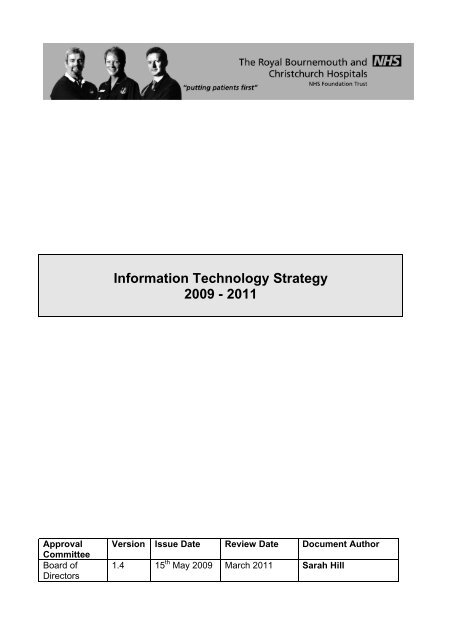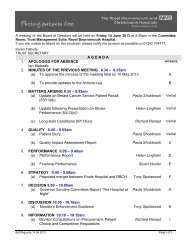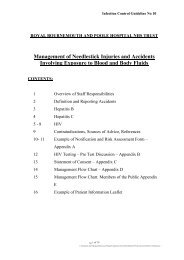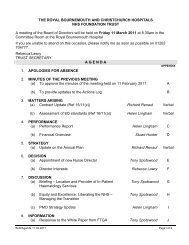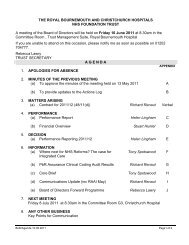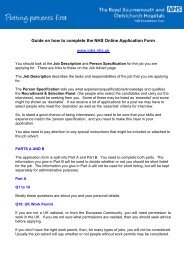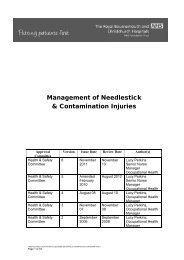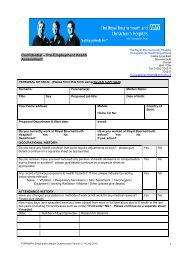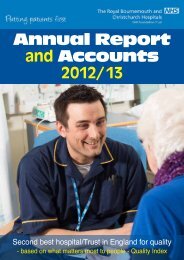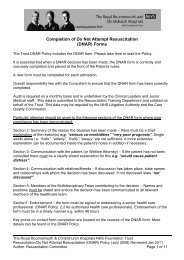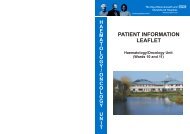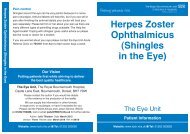Information Technology Strategy 2009 - Royal Bournemouth Hospital
Information Technology Strategy 2009 - Royal Bournemouth Hospital
Information Technology Strategy 2009 - Royal Bournemouth Hospital
You also want an ePaper? Increase the reach of your titles
YUMPU automatically turns print PDFs into web optimized ePapers that Google loves.
3.0 BASELINEIT Services DepartmentThe IT Services department is made up of 5 teamsSystems Management• Supporting the main Unix Servers, running applications such as the Patient AdministrationSystem CaMIS and the Finance system.• Clinical database design and support including the creation and development of theinfection control system• Internet / Intranet design and development• Integration Engine support and development to aid the introduction of new interfaces to linkIT Systems• Technical responsibility for the Management <strong>Information</strong> System• Responsible for SUS submissions for the TrustNetwork and PC Support• PC and Printer Support and Implementation• Supporting the Windows servers running applications such as the Trusts’ email• Network support and installation of new network points as required• Security issues such as Anti Virus control and encryptionIT Projects• IT Project Management support for major IT projects in the Trust such as electronicPrescribing.• IT Project Management support for minor implementations such as introducing interfaces tolink two current systemsApplication Support and Data Quality• Support for the main IT Systems in the Trust including CaMIS / eCaMIS / TomcatCardiology• Project support for eCaMIS / CaMIS / Tomcat system developments such as theimplementation of the Order Communications system• IT Helpdesk provision• Day to day responsibility for the validation and checking of the patient data in the mainCaMIS systemIT Training• Provide IT Training to all staff in the Trust both in clinical systems and administrativesystems such as the Microsoft Office suite• Offer courses to the hospital staff to assist them in gaining essential IT Skills so that theycan work with the new technology more quickly and efficiently. Currently the EuropeanComputer Driving License (ECDL) and Essential IT Skills (EITS) is the way we monitor that.• Timetabled courses are available for regular courses as well the provision of ad hoccourses• Ongoing review of developments in Training to ensure the best provision to the TrustWithin these teams the department offers helpdesk support from 8:30am – 5pm Monday to Fridayand Out of Hours Support 24 hours by 7 days a week.Author: Sarah Hill Page 5 of 26 The <strong>Royal</strong> <strong>Bournemouth</strong> & ChristchurchVersion: 1.4Date: 15 th May <strong>2009</strong><strong>Hospital</strong>s NHS Foundation Trust
during May/June <strong>2009</strong>. The Pathology system link for Order Communications has been a complexinterface. As at May <strong>2009</strong> a message has now successfully gone between the OrderCommunications and the Pathology system and therefore this should move forward duringMay/June <strong>2009</strong>. The system the Trust is implementing has the flexibility to cover other requestssuch as Endoscopy and Therapy services which will be looked at during <strong>2009</strong>/10. The introductionof a new Results Viewing module will be added on during June/July <strong>2009</strong> to support electronic signoff of reports.The introduction of Speech Recognition and Digital Dictation within eCaMIS now allows the clinicalstaff to record all their letters, whether desk work, after a clinic or a discharge for their secretariesto type elsewhere in the organisation.There are also a number of departmental Clinical Systems in the Trust• Symphony Emergency Department System. This was implemented in 2008 for use in theEmergency Department, CDU and AAU. This system supports the live tracking andmanagement of emergency patients.• HICSS (<strong>Hospital</strong> <strong>Information</strong> Clinical Support System) is the system in the Trust in use inclinical areas. This is used within Endoscopy, Gastroscopy, Eye Unit A&E, Rheumatology,Hepatology, Cataract Surgery and Gastroenterology.• Diabeta is the system in use in BDEC recording all clinical data about the patients seen as wellas producing documentation for GPs after visits.• Telepath Pathology system is located at Poole <strong>Hospital</strong> and managed by Poole on behalf ofboth Trusts.• Aspyra Picture Archiving and Communications System (PACS) is installed and fully usedwithin the Trust.• Tomcat Cardiology <strong>Information</strong> System is now successfully rolled out as the clinicalinformation system for the Cardiac department.• JAC is the Pharmacy System in the Trust and links are in place to ensure the full integrationwith the eCaMIS system with the TTO drugs feeding to Clinical Viewer.• Lilie GU Medicine system to capture their activity and clinical information.Ongoing review of IT hardware and Clinician training needs to continue to be prioritised across theTrust to assist this staff group in getting the most out of the IT Systems that exist in the Trust andreceive their input into future developments to the systems.The main non patient related system in the Trust is the eFinancial Finance System and theElectronic Staff Record (ESR) supplied by McKesson for the Payroll, training and HumanResources functions.Factors for ChangeThere are a number of factors that lead the IT Services Department and the Trust to review theircurrent IT services.Internal Factors• Age of equipment – There is an ongoing review of equipment and this is aligned to the ITCapital Plan to ensure the equipment is kept at a minimum standard.• Internal cost improvement programme - Looking at how systems are used and the costsaround those to see where improvements can be made to save money. An example of this isthe electronic transfer of letters to GP systems rather than printing and posting copies of letters.• Internal User Groups reviewing current systems – For all the CaMIS / eCaMIS and a number ofthe other systems there are user groups in place to review the systems and see how minoralterations can be made to get more out of the software to improve the way it works in theTrust.Author: Sarah Hill Page 7 of 26 The <strong>Royal</strong> <strong>Bournemouth</strong> & ChristchurchVersion: 1.4Date: 15 th May <strong>2009</strong><strong>Hospital</strong>s NHS Foundation Trust
External Factors• Department of Health setting new targets, such as the 18 week from Referral to Treatment.• Monitor setting out guidance to FTs to follow for such areas as the National Programme for IT.• Caldicott• Data Protection Act• Freedom of <strong>Information</strong>• National Service FrameworksNational Programme for IT (NPfIT) and the NHS Care Record Service (NCRS)NHS Connecting for Health (CfH), which came into operation on 1 st April 2005, is an agency of theDepartment of Health. CfH’s primary purpose is to deliver the National Programme for IT (NPfIT).NPfIT is a multi-billion pound IT project focused on improving patient care by enabling cliniciansand other NHS staff to increase their efficiency and effectiveness. Within NPfIT there are a numberof sub-projects/deliverables such as Choose and Book, GP to GP and the NHS Care RecordsSystem (NCRS). The NCRS is the only area of NPfIT outstanding for this Trust.As required by Monitor, an internal value for money review was conducted for NCRS in January2007. NCRS covers numerous key IT systems within RBCH including PAS, Theatres, A&E, WardPrescribing and Order Communications. The conclusion at the time was that the Trust were notminded to take the system.Since the review the Fujitsu’s contract covering the South of England was terminated in May 2008.Negotiations to reset the contract had failed because the two sides were unable to agree on theprice and commercial terms. The future arrangements for the South remain under discussion, butthe Department’s intention is allow those Trusts which have not yet implemented a new carerecords system to choose between those offered by the two remaining Local Service Providers, BTand CSC. The Cerner system has been implemented in a number of Trusts in London under BTand a few Trusts in the Southern area, this system continues to have some issues in theorganisations that are running it and still do not fully deliver the clinical requirements. Lorenzo isthe CSC NCRS Solution and is currently unable to fulfil the full requirements of the NCRS and isnot fully implemented in an Acute Trust.At this point in time agreement in Dorset has been given that during <strong>2009</strong>/10 a review will becarried out of the existing systems as well as the Local Service Provider solutions if those systemsare in a stable enough state for that review.A number of the NPfIT projects have already been met within the Trust.• Choose & Book - The Choose & Book link is now fully implemented to the CaMIS PatientAdministration System (PAS). This allows all the PCT / Patient / GP using Choose & Book toselect an appointment and book it directly onto the CaMIS PAS.• Data Quality Standards• The Trust has a Data Quality team that is focused on the Patient Master Index. The NHSnumber is the key field for all patient records and this teams’ primary focus is to resolve theNHS Number for all patient records in the CaMIS PAS.• N3 Network• The N3 Network is a dedicated national network across the NHS. This is the method thatthe Trust uses to access the Internet, send and receive email and access any externalsystems through secure firewalls. The Trust was connected to this during 2004.IT Steering GroupThe IT Steering Group is the Strategic group for IT in the Trust. The Group is made up ofclinicians, pharmacy, a GP representative, general management as well as IT representation andis chaired by the Director of Finance & IT. The group was set up to formulate the Trust’sAuthor: Sarah Hill Page 8 of 26 The <strong>Royal</strong> <strong>Bournemouth</strong> & ChristchurchVersion: 1.4Date: 15 th May <strong>2009</strong><strong>Hospital</strong>s NHS Foundation Trust
<strong>Information</strong> Management and <strong>Technology</strong> <strong>Strategy</strong> taking into account local recommendations aswell as the National Programme for IT. All major IT purchases have to be approved by the ITSteering group to ensure central control of any IT related purchases.The IT Steering group approve all the IT related Policies for the Trust as well as direct and approvethe spend of the IT Capital budget.Appendix 2 (available on request) – IT Steering Group Terms of Reference – available on requestDorset Informatics BoardThe Dorset Informatics Board is compiled of Finance Director or Chief Executive or Senior IT for allthe health organisations in Dorset. This group suggests the IT direction and IT projects for reviewfor all the organisations in Dorset. All updates and reviews of the National Programme for IT arepresented to the group to dictate actions for the IT groups to review.This Board has an advisory capacity only with no budget or management control. The purpose ofthe group is to share a common IT goal across Dorset for Healthcare.Appendix 3 (available on request) – Dorset Informatics Board Terms of Reference (available onrequest)Informatics PlanningThe following documents have been considered when writing this strategy- The National Informatics Plan (Appendix 4 – available on request)- The South West Informatics Planning Guidance <strong>2009</strong>/10 (Appendix 5 – available onrequest)- Dorset LHC Informatics Plan <strong>2009</strong>/10 (Appendix 6 – available on request)The main agenda for these documents are the Clinical 5:The Patient Administration system should have the capability to have integration with othersystems and support sophisticated reporting - The CaMIS / eCaMIS system currently in the Trustalready meets this requirement.Order Communications and Diagnostic Reporting - The eCaMIS Order Communications systemwill fully support this requirement and the development in June/July <strong>2009</strong> should fulfil the reportingand electronic sign off for this requirement.Letters with Coding - The electronic Immediate Discharge Form along with the GP letter from theSymphony Emergency system should combine with the other letters that are produced in the Trustto ensure that enough coding information is being electronically transmitted to GPs.Scheduling of Beds, Tests and Theatres - A review needs to take place in <strong>2009</strong>/10 to find out thegaps in the current eCaMIS system to fulfil the requirements on this issue but the current system isa large percentage of the way to meeting this need.ePrescribing - This is a project planned for <strong>2009</strong>/10.4.0 REVIEW OF 2007 – <strong>2009</strong> PROJECTSAccident & Emergency Management and Clinical SystemWith the introduction of the Symphony Emergency system the requirement for the data capturedevelopments within eCaMIS for CDU / AAU has been removed. The Symphony system wasAuthor: Sarah Hill Page 9 of 26 The <strong>Royal</strong> <strong>Bournemouth</strong> & ChristchurchVersion: 1.4Date: 15 th May <strong>2009</strong><strong>Hospital</strong>s NHS Foundation Trust
implemented in December 2008 to resolve all Emergency Care tracking in the EmergencyDepartment, Clinical Decision Unit and Acute Admissions Unit.The system has improved the live monitoring and tracking of patients within the EmergencyDepartment and related areas. This includes an electronic white board to show when patientsneed to be moved up the priority list and embedded guidelines to aid treatmentData quality with the Emergency Department is improved with increased data collection on clinicalinformation. This improved data quality provides the Trust with comprehensive payment by resultsinformation.The system will support Emergency Department moves towards being paper lite. The systemallows the reduced paper record to be scanned within the department. This would result in virtuallyno notes storage space being needed.The integration with AAU and CDU allows the automatic production of electronic GP dischargeletterseIDF (Electronic Immediate Discharge Form)During 2008/9 the introduction of the electronic immediate discharge form has been stilted due tothe complexity of the patients. An alternative, free text, version of the form is being launched inMay <strong>2009</strong> to try to cover this issue. From the 1 st April all patients discharged should have anagreed electronic discharge document.The current form is a manual form where minimal data is pulled into the form with the clinicianscompleting all the data in the form to support the discharge process, coding function andcorrespondence with GPs.A review has taken place of the eIDF and during June <strong>2009</strong> a new version of the form will beimplemented with the Co-Morbidities information automatically pulled into the form. In July /August <strong>2009</strong> another version of the form will be implemented to automatically pull in Theatres andWaiting List Management data. From this point a detailed review will be carried out to look at theautomatic population of the form feeding from the Order Communications, Radiology and otherrelated system.This should ensure that the eIDF is electronically populated and only GP instructions andadditional instructions for discharge need to be added.Additional PCs have been installed across the Trust to support the collection of the eIDF data andthis will continue to be reviewed.18 Week WaitThe CaMIS / eCaMIS system was updated in August 2008 to support the capture and tracking ofthe 18 week referral to treatment pathway for patients. The changes for users have beenconsiderable and a number of review meetings have taken place to ensure users are using thesystem correctly. The data from the system is now starting to be used in reporting of the 18 weekposition. This affords us the opportunity to identify issues and delays on patient’spathways thereby being able to implement required changes to minimise any breaches dueto <strong>Hospital</strong> processes and procedures.A few additional developments are required and are scheduled in <strong>2009</strong>/10 to try to ensure the olderactivity, pre August go live, is put onto a pathway as they are actioned.Author: Sarah Hill Page 10 of 26 The <strong>Royal</strong> <strong>Bournemouth</strong> & ChristchurchVersion: 1.4Date: 15 th May <strong>2009</strong><strong>Hospital</strong>s NHS Foundation Trust
To further support the use of the pathways within CaMIS / eCaMIS the system has beenconfigured to cope with emergency pathways where it does not create a Referral to treatmentPathway. The reason for this change is to ease the tracking of the use of the system by staff.Care PathwaysWith the introduction of the CaMIS / eCaMIS system the patient pathway is now clearer for trackingand monitoring. The funding for this development was spent on the Tracking module withineCaMIS which will allow the electronic tracking and movement of patients around the Trust. Thiswill support some element of care pathway tracking and the further use of Order Communicationswill also assist with this.Management <strong>Information</strong> SystemThe Management <strong>Information</strong> System is the Intranet based reporting system that pulls data fromthe main IT systems for reporting activity and performance data. A Steering Group was re-formedin March <strong>2009</strong> to ensure that this system delivers the required reports in a usable format for thesenior managers in the Trust.This system also supports the emailing out of reports to staff to action which should also speed upsome elements of validation in the Trust.The MIS should be the portal used and developed to share data with the Clinicians in the Trust sothey can review the current position with their patient lists. The <strong>Information</strong> Department have anumber of projects underway to push the roll out of this system across the Trust.The MIS supports the validation of Data Quality for NHS Number tracing but also for theSecondary User Service (SUS) extracts. This validation is carried out on a daily basis to ensurethe current data quality for inpatients and outpatients is maintained. The SUS extracts are used bythe PCT for contractual purposes.Developments in June <strong>2009</strong> will support the increased availability of Theatres data to enable moreenhanced Theatre utilisation reporting. Radiology reports are also being added in May <strong>2009</strong> tomake the availability of this data more wide spread and more easily viewed and shared.There has been an End of Life declared for the Support and Development of the current productthat we use as the front end of the reporting system for the MIS. This may mean that during thenext 3 years an alternative front end reporting tool is investigated. The supplier has been takenover by Microsoft so a product may be in the pipeline from them but this is currently unclear.Scanning of Medical CasenotesPhase I of the eCaMIS Scanning system has now been implemented and taken live. We havecommenced scanning Maternity notes and loading these into the system. A roll out plan iscurrently being devised in Health Records to move those notes which meet the scanning criteriaonto this electronic storage solution.Phase II of this system will provide the ability to electronically export documents, uploaddocuments into certain sections of the note, improved viewing of the documents, all of these withfull audit trail. This is due in <strong>2009</strong>/10.Digital Dictation / Speech RecognitionDigital dictation and speech recognition capability has recently been developed within eCaMIS andis intended to be used as an alternative to the traditional audio dictation cassette. Speechrecognition transcribes the spoken word with digital dictation only recording it.Author: Sarah Hill Page 11 of 26 The <strong>Royal</strong> <strong>Bournemouth</strong> & ChristchurchVersion: 1.4Date: 15 th May <strong>2009</strong><strong>Hospital</strong>s NHS Foundation Trust
All types of correspondence can be digitally recorded directly into eCaMIS, including; ward roundnotes, operation letters, discharge summaries, clinic letters and desk work. There has been acontinual roll out of digital dictation over the last few years with successful results and enthusiasticfeedback. The majority of specialities in the Trust are using digital dictation to some extent. Thekey benefits being:-• Once a dictation has been recorded it can be transcribed within minutes onto eCaMIS and bemade available for electronic transfer to GPs.• Risk of tapes being lost or damaged is eliminated.• Quality is far better than audio tapes• Background noise is reduced by digital filtering.• Analogue Dictaphones and tapes don’t need to be replaced, cutting costs.• Urgent letters are easily identified so they can be prioritised for processing.The roll out of speech recognition has not been as successful because it is a two step process andmost secretaries preferring to type letters rather than correct them. Real time speech recognitionwould be advantageous for areas with no secretarial support where clinicians can correct their owndictations in an easy, one-step process.Investigations are ongoing in <strong>2009</strong>/10 to utilise digital dictation for all correspondence i.e. patientrelated and non-patient related. This will incorporate using digital dictation in other patientmanagement systems such as Tomcat/Diabeta and dictating outside of the Trust to get the mostout of the current investment.Telemedicine for StrokeThe Telemedicine System has been installed in Accident and Emergency for the out of hour’streatment of Stroke patients.The system consists of a digital network including a 2-way video conference between the patientand physician and CT/MRI-image transfer using a high-speed-data transmission. The videocamera captures real-time clinical signs from the patient, and the computer screen enables thepatient to view and communicate with the remote "stroke expert”. Using the highest image andsound quality for simultaneous image transfer and medical communication between physician andpatient - each member of our on call Stroke Team have a small and high-grade workstation thatthey use via the 3G network to receive and send DICOM data and integrated PACS images. Thisenables the consultant to virtually assess the patient and take appropriate action.This project won the Health & Social Care Award for Innovation from the Department of Health inthe South West Region in May <strong>2009</strong>.N3 COINDuring 2008 a joint project between RBCH, Poole <strong>Hospital</strong> and BT N3SP was undertaken toprovide resiliency in both Trusts’ N3 connections. Up until this project both Trust's had to rely on asingle N3 connection each. Both of these connections terminated in the Poole BT exchange.The N3 COIN (Community of Interest Network) solution was to provide RBCH with a new higherbandwidth circuit to Southampton exchange using Virgin Media as a carrier. Poole <strong>Hospital</strong> kepttheir existing circuit to Poole exchange but with increased bandwidth. A third, triangulating, circuitwas then installed between RBCH and Poole hospital using a different carrier again. This providesboth Trusts with a resilient connection to N3 if a circuit should fail. The project was completed ontime and without any significant disruption to usersAuthor: Sarah Hill Page 12 of 26 The <strong>Royal</strong> <strong>Bournemouth</strong> & ChristchurchVersion: 1.4Date: 15 th May <strong>2009</strong><strong>Hospital</strong>s NHS Foundation Trust
5.0 SECURITY AND BUSINESS CONTINUITYSecurity and Virus ControlThere are a number of security solutions in the Trust to protect the organisation from any maliciousthreats.All the central servers are backed up and maintained by the IT Services department and theservers are located in the secure data center with back up tapes in a fire proof safe in theEducation Centre. PCs are not routinely setup to centrally backup, however this option is availableto staff. The IT Security Policy, available on the Intranet, lays out the security recommendationsfor staff in the Trust.Anti-Virus software is installed on all equipment in the Trust and is centrally maintained to ensurethis is kept up to date. The anti-virus software checks every few hours for updates via the web andthose updates are made onto the PCs in the Trust every four to six hours. There is always a smallrisk that a new virus may not be recognised and when an anti virus solution has not been identifiedand before the anti-virus software is updated, however this could only get into the Trust via theemail system.Email security has now been updated to protect the Trust against Spam/junk mail and there is alsofull anti-virus software on the email server. Access to the internet is subject to two levels ofsecurity device to protect the Trust. All active content on web pages is checked and there is URLfiltering in place which restricts sites that staff can access.We will shortly be implementing an email encryption solution which will enable seamlessencryption between all Health organisations in Dorset and any other Health organisation that usesthe same TLS technology in their email encryption appliances, without the need for any userintervention. The encryption appliances will also provide comprehensive anti-spam filtering andanti-virus scanning. It will also enable policy based encryption of email outside of the health arena.Outside of the health arena, on receipt of an encrypted email the receiver will be required toregister once with the Cisco CRES service to unencrypt the email. On subsequent receipts ofencrypted email the receiver will only have to logon to the Cisco CRES service to unencrypt theemail.Network security ensures that only valid equipment is connected to the computer network so thatsecurity is maintained. There are firewalls between the Trust and any external connection whichensures that no unauthorised access in or out can take place. The Wireless Local Area Networkdoes have a level of security built into it so we are secure but this is being updated and expandedin <strong>2009</strong>/10.Remote access security is tightly controlled with two alternative solutions available to staff,depending on connections at their home address. Both systems are secure with challengeresponse authentication devices ensuring secure access and they also have intrusion detectionand prevention which is checked daily.During 2006/2007 Windows Active directory was installed in the Trust and this provides centralauthentication and authorisation for any Windows based computer. Active directory also allowsadministrators to assign policies, deploy software and apply updates to the whole Trust from acentral system.Author: Sarah Hill Page 13 of 26 The <strong>Royal</strong> <strong>Bournemouth</strong> & ChristchurchVersion: 1.4Date: 15 th May <strong>2009</strong><strong>Hospital</strong>s NHS Foundation Trust
Security is monitored on an ongoing basis to see what needs to be investigated in the Trust toimprove the security that currently exists.Removable Media encryptionAs part of <strong>Information</strong> Security and <strong>Information</strong> Governance the Data Security in the Trust must belooked at to ensure any data movement is totally secure.Port control is a feature within the centrally purchased Device Control product and it allows centralcontrol of the use of removal media for the storage of data.The intention is to implement the following controls, as confirmed by the IT Steering Group:1. CD drives to be configured as read only across the Trust. The only exception for this is thecreation of PACS and Cardiac Image CDs where a separate encryption process must beused.2. USB devices to be configured so that all devices be read across the Trust. The PC andnetwork anti virus software will check for any security issues prior to accepting this dataonto the PCs.3. Recommended encrypted USB Devices can be used to write data to. These USB devicesmust be encrypted for the level of security required with this data. The list of recommendeddevices will be agreed between IT Services and Commercial Services so staff can go toCommercial Services to purchase these.4. Palm Pilot / PDA/iPhones – these are still to be clarified.Preparation has commenced in the Trust with the purchase of encrypted USB devices.Data CentreFollowing an IT Disaster Recovery Risk Analysis exercise in June 2006, significant risks wereidentified with housing most of the Trust’s IT equipment in the main <strong>Hospital</strong> telephone switchroom. As a result of this, funding was provided to facilitate the construction of a dedicatedComputer Room on the Trust campus. This project was completed with ongoing revenue costsincluded within the IT Budget.Since the completion of the data centre all the servers were relocated to the secure purpose builtcomputing facility located on the roof. Physical security includes fire protection, suppressant andresistant materials used in manufacture of the room. The floor is raised which protects the roomfrom flood. The physical location of the room is a theft deterrent, coupled with alarmed entry and akeyed lock that cannot be copied. The room is also protected by CCTV internally. A UPS(Uninterruptible Power Supply) supplies power to all servers in the room and generator powerensures the room is on essential power.Windows ServersAll windows servers are backed up either to disk or tape on a nightly basis, Monday to Friday. Acomprehensive backup tape rotation is followed to ensure a wide spread of backups available inthe case of an emergency. All windows servers have built in resilience comprising teamed networkconnections, redundant power supplies and fans as well as disk arrays allowing for a disk failurewithout data loss or system failure.All windows servers are covered by a 4 hour extended hours maintenance contract for repair orreplacement of faulty components.Author: Sarah Hill Page 14 of 26 The <strong>Royal</strong> <strong>Bournemouth</strong> & ChristchurchVersion: 1.4Date: 15 th May <strong>2009</strong><strong>Hospital</strong>s NHS Foundation Trust
The restoration of a server depending on the severity of the incident, can be completed within 1working day for a serious failure, subject to hardware being available or repaired, to 1 hour for asimple file restore if a user has corrupted or inadvertently deleted a file.With the current backup plan the maximum data loss would be 1 working day. This is felt to be anacceptable level of risk.Unix ServersThe main risks with the Unix servers are manual error, hardware failure (most components aredual redundant ie no single fault can cause a failure), Fire/Flood/Act of God and Theft. TheImplications of any of these would damage the availability of clinical systems (CaMIS / eCaMIS,Choose & Book, Radiology), support systems (Finance) and any dependant systems (Systems canbe reliant on CaMIS for interface connections) depending on the Unix server affected.There is a potential permanent loss of vital patient information core to the Trusts business andaffecting its operational capability.The restoration of a server varies greatly depending on the nature of the restore. DisasterRecovery invocation where a server is supplied on site can be up to 12 hours to restore. Simplehardware faults would be a maximum of 6 hours. Simple software faults or site correctiblehardware faults would be a maximum of 4 hours.Data is backed up to tape daily and stored in a safe in the education centre. Weekly and monthlycycling of tapes is performed, making it possible to retrieve data up to 2 months old if necessary.Tapes are replaced as required. Transaction logs are copied at more regular intervals (every hour)for those servers that support transaction logging (CaMIS, Choose & Book).Disaster Recovery testing is performed twice per year, either at an off-site facility or on-site. Testrecoveries are performed and procedures/timings are updated accordingly. Restore proceduresfor Radiology, CaMIS and Finance are held on site.With the current backup plan the maximum data loss would be 1 working day. This is felt to be anacceptable level of risk.Disaster RecoveryBased on experiences learned from 9/11 and the London Bombings, physical access to theappropriate buildings is necessary to recover services. In reality, denial of access can be a majorissue/delay whilst the relevant emergency services resolve the situation. To address this risk whichhas been added to the IT Risk Register a Trust Wide Business Continuity/Co-Location plan will beconstructed. This would allow for a backup location holding our data so the Trust could run fromthat site if anything should happen to the primary site.The construction of the Business Continuity / Co-Location Plan will be completed during <strong>2009</strong>/10and reviewed by the IT Steering Group to assess whether this should go forward as a proposal fora Capital Development in 2010/11.6.0 IT DEVELOPMENTSClinicalElectronic Prescribing / Medicines ManagementThis project was originally put in for 2007-09 but with the planned implementation of the Pharmacyrobot it was agreed that this project would be delayed until <strong>2009</strong>/10. A fact finding demonstrationand review meeting in January <strong>2009</strong> has confirmed clinical engagement to move this forward.Author: Sarah Hill Page 15 of 26 The <strong>Royal</strong> <strong>Bournemouth</strong> & ChristchurchVersion: 1.4Date: 15 th May <strong>2009</strong><strong>Hospital</strong>s NHS Foundation Trust
Electronic prescribing systems support the whole medicines use process. They will enablemedicines to be managed electronically at every stage, from prescribing through to supply andadministration. Electronic prescribing should facilitate wider improvements in prescribing andadministration processes, including reductions in paperwork / improved audit trails for medicationand improved communications. The software also incorporates decision support, aiding the choiceof medicines and other therapies with alerts such as drug interactions.Electronic prescribing and dispensing is a development that intends to be investigated due to theclinical benefits around this particularly in prescription errors / decision support. A review will becarried out with IT and Pharmacy during <strong>2009</strong>/10 to look at the 2 system options (1) an expansionof the JAC pharmacy system or (2) purchase the functionality within the Ascribe system being usedfor Order Communications. This is a major development with estimated costs of £300k.Chemotherapy PrescribingThe HOPS (Haematology Oncology Prescribing System) is currently in use in the Trust to supportchemotherapy prescribing. Across the Dorset Cancer Network it has been agreed that areplacement system for this needs to be considered.At RBCH an option would be to include the Chemotherapy prescribing within the ElectronicPrescribing project rather than purchase a separate IT solution. This will need to be reviewedwithin the electronic prescribing project.Cancer <strong>Information</strong> SystemWithin the Trust it has been supported for a number of years that a single Cancer <strong>Information</strong>System is required. Currently up to 10 separate systems are used to collect the specific cancersites and waiting list information. A Dorset Cancer Network project was running to look at theimplementation of a single system across Dorset, however this has now been abandoned andTrusts are being advised to select their own system to provide for this.RBCH are looking at a number of system choices for the collection, reporting and tracking ofCancer Patients and hope to look at implementing a system during <strong>2009</strong>/10. This is a mediumdevelopment of approximately £50k.Inpatient Tool for CliniciansThe Inpatient Tool moved forward during March <strong>2009</strong> when the discussion of a future developmentcommenced. The review of the requirements for this has changed from the original plans. This isdue to the planned changes to the eIDF. The requirement is now to create an electronic work listfor Inpatients. This has been specified and is moving forward. This is a medium development withestimated costs of £20k. ( c/fwd funding 08/09)Pathology System ReplacementThere are two elements to the Pathology System replacement that must be considered. These areHistopathology, which is a very text base requirement and report, and the blood sciences wherethey are more statistical results with feeds from analysers.Clinical agreement was gained at the IT Steering Group that the Histopathology IT requirementsare key to providing complete data based reports including Cancer profile completion. A NPfITproject had commenced looking at a Pathology system and this is being investigated as an option.However, at this point in time it is felt that there should remain one Pathology system due to thepurchase price and ongoing revenue consequences. Therefore the intention is that the Pathologysystem replacement takes place in 2010/11 in conjunction with Poole <strong>Hospital</strong>. At that point theAuthor: Sarah Hill Page 16 of 26 The <strong>Royal</strong> <strong>Bournemouth</strong> & ChristchurchVersion: 1.4Date: 15 th May <strong>2009</strong><strong>Hospital</strong>s NHS Foundation Trust
Histopathology requirements must have a high priority in the specification of the new system toensure their clinical requirements are met.The pathology system replacement is a large development with an estimated cost of £250k.Orthodontic System ReplacementThe current Orthodontic system needs to be reviewed and potentially replaced. The currentsystem does not currently support a full clinical system for the department. The paper notes arecurrently required to be able to manage the patient. Therefore a system replacement will belooked at to move forward with a paper lite solution. This is a medium development with anestimated cost of £50,000.Clinical Outcome DataThe Introduction of the Commissioning for Quality and Innovation (CQUIN) may identify the needfor additional clinical outcome data to be collected within current IT systems. This requirement iscurrently unknown but a budget will be allocated towards this to assist in the collection of data tosupport CQUIN. This is a medium development of an estimated £20,000.Clinical Viewer LinksThere are a few remaining systems that are not feeding clinical reports and data into the eCaMISClinical Viewer system and this is a requirement to create a central clinical record. An example ofthis is a link to the DAWN Warfarin system and the Thoracic Spirometry system. This is a mediumdevelopment of an estimated £20,000.Maternity SystemTo date the Maternity department at the Trust have used elements of the CaMIS PatientAdministration System to collect information about their activity in Outpatients and Inpatients. Alsothey use a web link to the NHS Number for Babies site to register babies to get NHS numbers forthem at birth. These systems have not fully supported the requirements of the department andhave not supported the ongoing planning of the staff in terms of expected deliveries.Therefore a Maternity System needs to be implemented in the Trust to support this clinicalfunction. This is a medium development of approximately £50k.Business ProcessRadiology <strong>Information</strong> System (RIS)The introduction of Order Communications and the attempt to introduce Digital Dictation withinRadiology has highlighted the shortcomings of the current RIS. The Radiology department iscurrently reliant on a request form to move a patient around the department as this documenttriggers the next step in their pathway. As part of the Order Communications system the idea ofremoving the request form was abandoned as the RIS could not support a paperless process.Digital Dictation was to be introduced within Radiology but the clinical staff were concerned aboutthe lack of links between the RIS and the PACS which raised concerns over errors or dictatingreports on the wrong patient.A re-design specification has been created with the assumption that this is the route the Trust willtake, however this is under review with the current concerns about the lifetime of the currentPACS. This is a large development with estimated costs of £60k. (c/fwd funding from 08/09)Author: Sarah Hill Page 17 of 26 The <strong>Royal</strong> <strong>Bournemouth</strong> & ChristchurchVersion: 1.4Date: 15 th May <strong>2009</strong><strong>Hospital</strong>s NHS Foundation Trust
AdministrativeWebsite Re-DesignIT will be focussing on restructuring the web content in-line with the specification of marketing andcommunications and changing the look and feel where it is deemed appropriate. Visual and audiomedia will be used to a greater degree – though the implications and associated resource costs ofcreating such productions must also be considered.Social networking platforms are an area that we need to investigate for the website. It isconsidered that more work needs to be done on the management of perception; as presented viaNHS Choices and any disassociated forum. Social networking tools can themselves be used forthis purpose, but before adding to the burden; we should devise methods of managing the variousareas where negative opinion may currently be presented.Discussion with NHS Choices has led us to believe that we can integrate our site tightly with theNHS Choices site. A key element that we would gain out of this is providing an online feedbackform to patients on our site that posts feedback directly to the NHS Choices site, via theirmoderation processes. We could also pull this feedback back to our own site via their RSS feed.This would result in a central online store of patient feedback that users can access and add tofrom multiple locations.Web Site AccessibilityThe redevelopment of our external website should be considered a priority in order for us to meetlegal requirements defined in the Disability Discrimination Act (DDA 1995) and the DisabilityDiscrimination Act Code of Practice (DDA-CoP 2002) for web accessibility.Redeveloping our website to meet the Web Content Accessibility Guidelines (WCAG) 2.0compliance level AAA will exceed the legal requirements and result in a website that will be fullyaccessible to the vast majority of groups. It will also place our website higher in search enginerankings, resulting in more visitors to the site.Content ManagementImplementation of a Content Management System (CMS) on the external website to allow for adocument control process, including approval and versioning mechanisms. A CMS would permitcontent to expire, automatically removing it from the website where practical, and would create theoption to distribute content management throughout the Trust. The CMS will integrate with ourdocument management system which manages approval mechanisms (workflow), versionmanagement, storage and delivery of core protocols and procedures etc.After these essential changes are implemented we would be able to look at implementing a richer,more dynamic user environment, resulting in the provision of both a web site and web services.This is a large development with a cost of approximately £100k.Use of mobile devices and email messagingOnce the core patient record on the Patient Administration System has the capability to store themobile number and email address of the patient, we intend on implementing basic services –appointment reminders, pathology result notification etc. Email and electronic interchange formspart of the paperless component of the IT <strong>Strategy</strong>. Due to confidentiality and governanceAuthor: Sarah Hill Page 18 of 26 The <strong>Royal</strong> <strong>Bournemouth</strong> & ChristchurchVersion: 1.4Date: 15 th May <strong>2009</strong><strong>Hospital</strong>s NHS Foundation Trust
equirements there are limitations on the types of information and transmission mechanisms thatcan be used to communicate directly with patients – where possible we intend on implementingelectronic communication if preferred.Self Service <strong>Information</strong> KiosksSelf Check-in screens have been implemented in the main clinic areas in the Trust to supportpatients self arriving to clinic. With the use of this system we can continue to carry out thedemographic checks required and electronically arrive patients in clinic.The extension to this or introduction of additional kiosks is being investigated to look at the abilityfor on line questionnaires, update on waiting times and way finding around the Trust.eCaMIS Theatre SystemThe current eCaMIS Theatre System has been in the organisation for a number of years now andshould be reviewed alongside the care pathway work being done to support the 18 week wait work.The Trust will need to ensure that the system fully supports direct booking, equipment ordering andimproved scheduling.eTCI (eCaMIS To Come In)A development is being investigated to look at the Admissions process in the Trust. This includesthe replacement of the current TCI cards in the Trust with an electronic form. As part of thisdevelopment there is also an intention to put the screening forms on eCaMIS and review thescreening process of patients to ensure they are fit to go onto Inpatient and Day Case Waiting Listsfor scheduling.Customer Relationship Management (CRM)The current system that is used to support the Foundation Trust members has been developed inhouse but it has been agreed that this no longer meets the requirements of the Trust and themandatory submissions required by Monitor.During <strong>2009</strong>/10 a new Foundation Trust Membership will be investigated and selected to resolvethe data collection and management reporting required for Trust members.Single Assessment ProcessThe Single Assessment Process is used to ensure that patients receive appropriate, effective andtimely responses to their health and social care needs. Through the use of shared assessmentdocuments the agencies involved in the patient’s care share their information. Currently the singleassessment process is a manual process across Dorset. The PAN Dorset SAP Steering Grouphas been reviewing the option of an IT System to support this process across Dorset. The solutionwill allow the entry of the Assessment into the IT system for all staff in the process to be able tomonitor and review, as well as having access to the record from the Accident and Emergencydepartment. This is a medium development with estimated costs of £20k. (c/fwd funding 08/09)eLearningNew <strong>Information</strong> Governance guidelines and a greater reliance on the use of Patient ManagementSystems highlighted the need for more flexible options to train new staff and update existing staffon the systems currently in use. The use and development of eLearning was investigated as anoption to address issues such as difficulties with releasing staff from their work environment, moretimely training of staff and some Mandatory Training issues at the Trust.Author: Sarah Hill Page 19 of 26 The <strong>Royal</strong> <strong>Bournemouth</strong> & ChristchurchVersion: 1.4Date: 15 th May <strong>2009</strong><strong>Hospital</strong>s NHS Foundation Trust
Two solutions were required; a Learning Management System (LMS) to access eLearning andrecord its completion; and eLearning Authoring software to create our own local in-house e-learning content.Learning Management System; we decided to utilise the National Learning Management System(NLMS), a joint initiative between the Department of Health, NHS Connecting for Health and ESRproject because:-• It was provided free of charge to NHS Organisations saving the cost of purchase,implementation, maintenance & support of 3rd party solution• Enables the delivery of national & local e-learning content to employees - e-learning beingavailable to all employees with a staff record on ESR.• Centralises the Trusts Training services, with all departments using one system to recordtraining activity. This provides a complete picture of an employees individual training record.• Integrated with payroll and HR systems to provide a single, complete employee record createdand maintained with training history, competency profile, qualifications, schools & colleges andappraisal details.• Option to automatically update ESR employee records with training undertaken, competenciesand qualifications achieved.• National competency frameworks are built in (KSF, NOS, NWC) plus ability to define localcompetencies and rating scales e.g. mandatory refresher training can be identified andreported on when the competence is ready for renewal.• Creates a portable training record for employees who transfer to other NHS Trusts.• Self Service functionality allows employees to view all course offerings and play e-learningcourses. Some courses also allow self enrolment!• Skills matching, skill gaps and requirements can be highlighted with the ability to createlearning paths. Training can be targeted to match career frameworks reducing costs andimproving employee feedback.• Enables remote access to e-learning content, but ensures security of ESR core application.Authoring Software; we purchased KS Tutor supplied by Knowledge Solutions to create our owneLearning content because this software enabled both eLearning content and system simulationcontent to be created. It met the requirements laid down by the Learning and Developmentcommittee e.g. inbuilt checks to ensure that the learner has completed all areas of the course andSCORM compliant to ensure compatibility with the NLMS etc. It also enables us to provide ‘pointof access’ eLearning i.e. context specific help whilst in the live application.We are currently using the NLMS for NHS ELITE & NHS Health (nationally provided eLearning).The next step is to add our own authored eLearning content for RBCH specific PatientManagement Systems and for the national <strong>Information</strong> Governance eLearning when it becomesavailable.Our aim for the future is to expand our eLearning catalogue providing employees’ with greaterflexibility and a choice as to how they learn e.g. instructor led sessions or eLearning.Document Storage / Scanning Solution for Non Patient DocumentsStarting in April <strong>2009</strong> the Trust is implementing the ImageNow Document Management solution,initially as a pilot within 4 business area’s: Accounts Payable, Human Resources, RiskManagement and Commercial Services with the key driver being to provide a scalable solution withthe ability to move as much of their paper and processes to a paperless system as possible. Thiswas further extended to include a Reference Database trial for clinical material collected by theOncology Department and to provide various departments a platform for their meetings to gopaperless.Author: Sarah Hill Page 20 of 26 The <strong>Royal</strong> <strong>Bournemouth</strong> & ChristchurchVersion: 1.4Date: 15 th May <strong>2009</strong><strong>Hospital</strong>s NHS Foundation Trust
At a high level ImageNow creates a direct and effortless connection between workers and thedocuments they need to complete their daily activities. ImageNow allows customers to efficientlycapture and organize all types of documents, then retrieve a precise page instantly from within anybusiness application at the moment it's needed. From a Trust perspective Accounts Payable usethe system to scan and electronically sign-off invoices, coupled with the scanning of goods-inreceipts which is linked to our Powergate requisitioning system. Risk Management use it to capturea variety of forms, including: Adverse Incident Report, Risk Assessments, IOSH forms (RiskManagement course), Closed Claims & Training Records. Commercials Services in tandem withAccounts Payable, also take advantage of the link to Powergate and use the system for thestorage and collection of documents relating to tenders and general procurement. HumanResources have used the system to store leavers personnel records in conjunction with trialing theability of moving all members of staff personnel files to the document store. This department hasalso taken advantage of the workflow capabilities, using it to route and file paperwork between thedifferent HR locations and to move the “new hire of staff” process to as paperless a system aspossible.The benefits of doing this project include:• Free up physical storage space (e.g. 4000+ personal records/files for HR);• Eliminate lost documents in the organisation and reduce “time to find”;• Current paper based workflows (e.g. approval of invoices) will have the ability to go electronic;• Aids the implementation of robust document retention policies; improving compliance;• Multiple access to the same document with version control;• Audit control (who looks at any document, checks out etc);• Provides a platform for meetings to go paperless.The general objectives for this deployment address the following business needs:• Provide an enterprise document management, imaging and workflow solution integrated withthe Trust’s business applications• A reduction in the amount of paper file storage at the Trust• Improve and speed up the retrieval of information once scanned• Reduce the amount of printing at the Trust, taking advantage of the associated cost savings• Provide a central, secure and robust platform for the storage• A move towards paperless meetings• Assist with the compliance with regulatory and legislative requirements for the storage andretention of paper documents• Use as a project management tool, providing version control and central document storagefacilities (to improve project management efficiency)• Overall reduction in “paper”• Provide a solution fully supported for all Trust locations• Provide a solution scalable and flexible, supporting a growing environment• Provide a solution rich in functionality with the ability to add additional software modules.Office 2007IT will target to complete the implementation of Office 2007 during the <strong>2009</strong>-2011 period. Thisimplementation will be a major change for the Trust as the systems are quite different so extensivetraining courses will need to be available before any upgrade can be carried out.eCaMIS / Tomcat link for Cardiology Activity DataThe Tomcat Cardiology system is currently fed Patient Demographic <strong>Information</strong> and, throughOrder Communications, it will feed the Results/Reports back to eCaMIS Clinical Viewer. Anadditional link is required to feed the activity data from the Tomcat Cardiology system to the CaMIS/ eCaMIS Patient Administration System.Author: Sarah Hill Page 21 of 26 The <strong>Royal</strong> <strong>Bournemouth</strong> & ChristchurchVersion: 1.4Date: 15 th May <strong>2009</strong><strong>Hospital</strong>s NHS Foundation Trust
The activity that will be sent into the PAS can then be extracted as required for charging to thePCT. This development is dependent on the Tomcat system supplier supporting the changesrequired by the Trust to facilitate this. This development in an unknown cost at this point but wouldbe justified based on additional income.eCaMIS / Diabetic link for Co-Morbidity DataThe Diabetic system Diabeta is currently used to record clinical information about patients in thattreatment area. There is a demographic link to this system from the eCaMIS PatientAdministration System and the letters on the Diabetic system are also available on the eCaMISClinical Viewer.To further expand this sharing of data a link is currently being investigated to share co-morbiditydata between the Diabetic system and the eCaMIS system. This is to ensure that duplicate entryis not required in the Trust.The InfrastructureRadio Frequency Identification (RFID)This technology allows the tracking of people / items across the Trust using a radio frequencydevice and transmitters. In June 2007 the first project of this type went live in RBCH with thetracking of wandering patients. This allows patients / babies that are at risk to wear a RFIDbracelet and there are transmitters around the Trust that will flag alarms and messages when thepatient moves into certain areas.Further developments to this technology could allow the tracking of expensive assets in the Trustas well as potentially patient notes. The intention is to the use the wireless network in the Trustwhich should support coverage across the whole Trust by the end of <strong>2009</strong>/10.Wireless Local Area NetworkFurther areas to be improved on the Wireless Local Area Network are:• The wireless network does not have a wireless firewall or intrusion prevention system• There has been no test of broadcast signal strength for security purposes• There has been no attempt to detect unapproved wireless networks.The implementation of the upgrade of the wireless network to give full site coverage for data,image and voice with plans to complete this in <strong>2009</strong>/10. This is a large development in 9/10 withestimated costs of £300k.Voice over IP (VoIP)VoIP is a new technology that allows telephones and data networks to travel along the same linesin the Trust. This improves flexibility of moves around the organisation as the telephone wouldhave an IP address which would be movable without any external settings.There are some equipment costs such as servers and additional networking to implement thiswhich would support the Call Manager system which routes and controls the calls. The higher costwould be around the change of the telephones to IP based phones as this would be an initialexpense.A pilot of VOIP is intended in 2010/11 to put an IP telephone on each ward area. This will allowthe testing of this technology but also provide an alternative phone route should there be a need inan emergency situation. This is a medium development of approximately £50k.Author: Sarah Hill Page 22 of 26 The <strong>Royal</strong> <strong>Bournemouth</strong> & ChristchurchVersion: 1.4Date: 15 th May <strong>2009</strong><strong>Hospital</strong>s NHS Foundation Trust
National RequirementsSummary Care Record SystemThe overall goal of the NHS Care Record Service Programme is to deliver an integrated carerecord for the NHS in England. This consists of 2 parts, patient’s demographics and Clinical<strong>Information</strong>.The Demographics Programme is tasked to provide a national, authoritative source ofdemographics for the whole of the NHS, underpinning all national and local NHS Care RecordService Applications. This is known as the Personal Demographic Service (PDS). The PDSservice can be used accurately and efficiently to trace patients against a patient’s most up to datedemographic details, thus identifying the patient’s NHS Number.The Clinical Record is due to be implemented in two phases. The first phase is an early adopterphase based on the General Practice contribution to the NHS Summary Record and access to thissummary information from an unscheduled care setting, such as Accident and Emergency.Dorset PCT have are an Early Adopter for this project working to send GP allergy and druginformation to the Summary Care Record. In March <strong>2009</strong> RBCH FT were accepted as a fastfollower pilot to work with NHS <strong>Bournemouth</strong> and Poole on the Summary Care Record project withlinks to the Ascribe Symphony Emergency Department system.The links and work required for the Symphony changes are currently unknown but has beenestimated at a medium development with estimated costs of £20k. (c/fwd funding 08/09)GP DevelopmentsGPs are important to the organisation and as a result investment has been made to improve thedata available to the GPs in our locality.Web Clinical ViewerOver 1800 users are registered on the Web Clinical Viewer system, these are users from externalorganisations, primarily GP practices. This system has access to the same data as the Trustbased eCaMIS Clinical Viewer but in an internet browser. This system allows the GP to see all theclinical and administrative information the Trust has about the patient. There are restrictions so theGPs can only see patients in their practice. The implementation of automated password changeon the Web CV has increased the security of this application and made it easier for GPs toremember passwords on the system.Investigations are currently underway to link in Document Scanning to the Web Clinical Viewer sothat GPs could see the actual scanned documents on the patient record.Picture Archiving System (PACS) ViewerA development was purchased to our PACS system for 20 licences for GPs to access a webviewer of the PACS system. This allows the GP to see the actual PACS image as well as thereport for the patient.Electronic Transfer of LettersThe electronic transfer of letters from the Trust to GPs has been an ongoing project during 2008/9.With developments in the PCT the plan is for all GPs to be able to receive electronic documentsduring <strong>2009</strong>/10.Author: Sarah Hill Page 23 of 26 The <strong>Royal</strong> <strong>Bournemouth</strong> & ChristchurchVersion: 1.4Date: 15 th May <strong>2009</strong><strong>Hospital</strong>s NHS Foundation Trust
To this end test messages are being sent to GPs during May <strong>2009</strong> to ensure we can meet thisdeadline. The intention is that all letters created in eCaMIS such as Clinic letters, immediatedischarge form, discharge letters, operation letters will all be available to be electronicallysubmitted. Also developments are underway to support electronic letters from the HICSS systemfor Endoscopy, Gastroenterology, Eye Unit A&E etc. The Symphony implementation also providesan electronic GP letter module to support their letters being electronically submitted to GPs.This should ensure that the Trust can electronically send all documents to GPs in Dorset during<strong>2009</strong>/10. Work has commenced with Hampshire to look at a solution for that area also.Order CommunicationsCurrently the GPs complete request forms to refer patients into the Trust. These forms arecompleted by hand resulting in data quality issues and further errors result from re-typing into thesystem.The PCTs in East Dorset are investigating potential solutions to this and there are a number ofsystems available which would link from the GP system to the ordering system. The indicationsare that the Trusts would benefit as much from this as the GPs therefore there would be acontribution to this project required from the Trust. This would feed the requests directly into theTrust in the same way the Trust Order Communications does.7.0 FUTURE DEVELOPMENT POSSIBILITIESMain CaMIS / eCaMIS ServerIn January 2006 funding was approved for the replacement/upgrade of the Trust’s main computersystem, the CaMIS Server. This project was completed with ongoing revenue costs included withinthe IT Budget.As part of this upgrade, additional ‘spare’ processor capacity was delivered by Hewlett Packard(HP). When this additional capacity is required, the Trust will be required to pay pre-agreed extramonies to activate the hardware. The funding of this must be included within the future eCaMIS /CaMIS related projects where a risk is identified that additional processing power may be required.In the next 2 years RBCH will need to review the existing CaMIS Server on the following grounds:• Performance/scalability• Operating system (as dictated by HP, Trust will need to migrate away from Tru64)• NPfIT / NCRS• Hardware supportThis will be done in conjunction with the CaMIS supplier as the application will need to be ported toa new operating system platform with estimated future costs of £250k.PACS ReviewA review of the current PACS system needs to be carried out due to the end of life announcementof the current PACS. Part of this review should look at the clinical requirements as well asradiology requirements of the system and the links between RBCH FT and Poole <strong>Hospital</strong> toensure that any clinically relevant images are shared between the organisations.Author: Sarah Hill Page 24 of 26 The <strong>Royal</strong> <strong>Bournemouth</strong> & ChristchurchVersion: 1.4Date: 15 th May <strong>2009</strong><strong>Hospital</strong>s NHS Foundation Trust
8.0 RISKSDetailed below are the risks highlighted as part of the strategyAscribeThe CaMIS / eCaMIS system was developed by <strong>Hospital</strong> Engineering <strong>Information</strong> Systems (HEIS)and over the last 12 years the Trust has increased the amount of applications in use from thissupplier. During 2006/7 HEIS was acquired by Ascribe which is a software company that startedbusiness focusing on Pharmacy System Solutions but who have developed its portfolio to cover allaspects of NHS system solutions. Due to the amount of software already with this company andthe planned increase with the projects listed in this document the financial viability and risk of thiscompany has been investigated.Ascribe financialsAscribe was incorporated in October 2001 as a private limited company. Ascribe acquired HEIS in2006. HEIS has provided the Trust with product development and maintenance support to CaMISfor approximately 10 years prior to the acquisition date.A financial analysis report provided by Dun & Bradstreet shows the company as generatingturnover of £6.2m in 2004 rising each subsequent year to £17.4m in 2008. Profits before tax rosefrom £0.1m in 2004 to £3.8m in 2008. In terms of company failure, it scores 47 out of 100, whichmeans that 53% of UK businesses have a lower risk of failure in the Dun & Bradstreet database.The company’s strategy has placed itself in the market to sell directly to hospitals to providesolutions, which are compliant with the NPfIT initiation.The company’s liquidity has improved from a worrying position as at 30 th June 2007 when it itrecorded net current liabilities of £3.0m to £1.2m as at 30 th June 2008. The company claims it hasa strong order book but must be in a position to deal with its cash flow issues.The risk is not seen as sufficiently high to cause a problem but will continue to be monitored. SeeAppendix 7 (available on request) for additional financial information if required.Appendix 8 (available on request) is a response from Ascribe Finance Director on the risk review.NHS Care Record SystemThe current position with the National provision of an NHS Care Record System is unknown for theSouth West at this point. Attendance at the Chief <strong>Information</strong> Officer Forum and the DorsetInformatics Board is where an update should be received to be able to understand how thechanges affect the Trust.IT Department Skills and KnowledgeWith an ever changing IT environment one of the challenges faced by the IT Services departmentis to keep up with the current technology and the skills to support that.Through the use of the Training allocation to IT Services the skills within the department willcontinue to be monitored and developed to meet the changing demands for support andimplementation of IT systems.Author: Sarah Hill Page 25 of 26 The <strong>Royal</strong> <strong>Bournemouth</strong> & ChristchurchVersion: 1.4Date: 15 th May <strong>2009</strong><strong>Hospital</strong>s NHS Foundation Trust
9.0 SUMMARYThis <strong>Strategy</strong> sets out the current baseline of the IT systems and Infrastructure in place. It alsosets out a challenging list of developments and projects for the IT Services department to progressduring <strong>2009</strong> – 2011. These projects take into account external and internal factors and can besummarised in the following list of actions split between <strong>2009</strong>/10 and 2010/11.<strong>2009</strong>/10• Electronic Prescribing• IPS Junior Doctor ToolClinical• Clinical Outcome <strong>Information</strong>• Clinical Viewer Links• Cancer <strong>Information</strong> System• RIS RedesignBusiness• Document storage link to theProcessIntranet / Internet site.Administrative • Single Assessment Process• Wireless Network ExpansionInfrastructure• Replacement of old IT hardwareNational • Summary Care RecordRequirementsGP• GP Order CommunicationsDevelopmentsClinicalBusinessProcessInfrastructure2010/11• Pathology System Replacement• Orthodontic System Replacement• Maternity System Implementation• Web Site Content ManagementSystem• Network Upgrade• Voice Over IP Pilot10.0 RECOMMENDATIONSThe Board of Directors is asked to comment on and approve this report as the IT <strong>Strategy</strong> for theTrust for <strong>2009</strong>-11.Author: Sarah Hill Page 26 of 26 The <strong>Royal</strong> <strong>Bournemouth</strong> & ChristchurchVersion: 1.4Date: 15 th May <strong>2009</strong><strong>Hospital</strong>s NHS Foundation Trust


